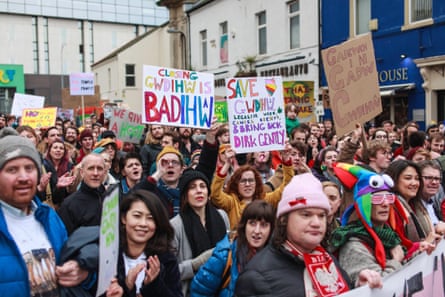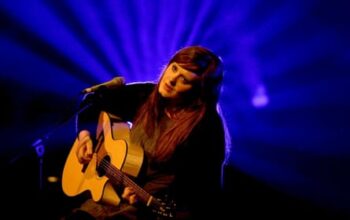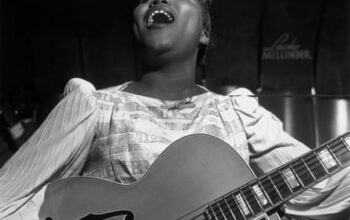‘In these stones, horizons sing,” reads a striking copper inscription above the entrance to the Wales Millennium Centre, an arts venue in the heart of Cardiff Bay. The six-foot-high words, written by poet Gwyneth Lewis, speak to the multiplicity of creative voices within the city, one whose music scene has long been overlooked and its diverse, tenacious people underestimated.
Located just streets away from Butetown, one of the UK’s oldest multicultural hubs, the venue forms a key part of the new, month-long Cardiff Music City festival. Pre-existing events such as the new-music-focused weekender Sŵn will combine with new opera art installations, inclusive “little gigs” for school-age performers, and unique one-off shows (such as a double bill of Leftfield and Orbital). Cult pop acts Fabiana Palladino and Porridge Radio are on the lineup alongside experimental composer Gwen Siôn – whose piece Llwch a Llechi mixes field recordings, one of Wales’s oldest male voice choir and electronic instruments fashioned from wood and slate – plus Tuareg rock, Butetown jazz and Noongar-language songs from western Australia.
Cardiff Music City is not just another newcomer in the UK festival marketplace but the culmination of two fierce fightbacks by the city’s cultural scene. In 2017, independent venues situated along the centrally located Womanby Street were jeopardised due to the proposed openings of new residential properties and a Wetherspoon’s hotel, and the noise complaints they could bring. In response, local residents joined together in street marches, putting pressure on the council to formally recognise the vitality of this “music quarter” – from Fuel, a dedicated rock and metal club, to the internationally renowned Clwb Ifor Bach. “It was a powerful moment that brought thousands of people together,” says Adam Williams, Clwb’s head of music.

Weeks of rallying proved successful. “That moment was the catalyst for us to really start thinking seriously about the value music has to the city,” says Cardiff Council leader, Huw Thomas. The planning application to redevelop Womanby Street was withdrawn entirely, and by December, the cultural consultancy firm Sound Diplomacy were commissioned by Cardiff Council to produce a strategy to help develop the city’s music scene in the aftermath of the marches. “We knew we had to listen to the sector,” Thomas says.
But in the months leading up to the publication of the Cardiff Music Strategy in April 2019, a handful of venues elsewhere in the city closed – among them DIY-minded Gwdihŵ (Welsh for owl) and indie bar Buffalo – due to a sharp increase in business rates and plans to turn each site into commercial units. These losses, and the further campaigning and collective action they inspired, further informed the report’s 12 recommendations to help protect and promote music at all levels in the Welsh capital – including with the Cardiff Music City festival.

Thomas says the council is now dedicated to “developing talent in our schools, protecting our grassroots music venues, and creating the infrastructure needed to achieve our aspiration of being a world-class music city.” The strategy also prompted a Music Board comprising councillors, venue operators and journalists, as well as a dedicated music officer in the council “whose focus is solely on working with the industry,” says Thomas. “It’s all helped get us to a place where people working in music in Cardiff understand we can’t solve every problem, but know that if we can find a way to help, then we will.”
The strategy was a national first – Belfast (who also engaged Sound Diplomacy) and Liverpool have since published similar reports to aid the post-pandemic recovery of their respective music scenes – and has strengthened Cardiff, says Tom Rees of local indie band Buzzard Buzzard Buzzard. “The council and local funding bodies have been really keen to support existing individuals who contribute to the scene, which is certainly an improvement on where we were,” he says. This began with a series of open-air gigs at Cardiff Castle to support local independent venues after the pandemic, while at the start of the year, the Music Board contributed to securing new premises for multi-arts hub Porter’s.
Rees wrote 2021 single Crescent Man vs Demolition Dan after protests to save Gwdihŵ – the venue “didn’t get the support it deserved” from the council, he says, adding that there is still a need for more grassroots spaces to make up for what was lost: “The period of tension hasn’t entirely gone away and a lot of artists in Cardiff still feel disillusioned with the industry – but I respect the work that is being done to try and resolve that.” He says that the Cardiff Music City festival is also worthwhile, “a good opportunity to take stock of everything that’s changed”.

Reggae artist and Welsh music prize nominee Aleighcia Scott agrees: “Wales is known as the land of song, so it’s only right for the capital to be a home for that,” she says, adding that the positive progress of the past half-decade has allowed for a collaborative spirit to strengthen among emerging Welsh talent, reflected across the Cardiff Music City lineup. Next month, Scott will perform on the same bill as soul and hip-hop acts, plus Welsh bilingual drill rapper Sage Todz, as part of a show co-organised with the Mobo awards.
Back at the Wales Millennium Centre, creative director Graeme Farrow hopes that the festival will continue to foster this kind of community and particular local flavour. “People have always been so humble about what Cardiff can offer,” he says. “I’m hoping that this festival will not only reverse that trend, but allow us to start screaming out that this is a place with a really distinctive voice.”
Source: theguardian.com


